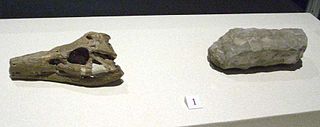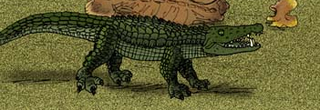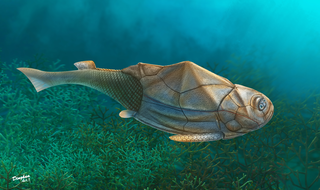
Miodentosaurus is a genus of thalattosaurian from the Late Triassic of China. It is one of several thalattosaurs found in the Xiaowa Formation, also known as the Wayao Member of the Falang Formation. The genus name "Miodentosaurus" translates to "Few toothed-lizard" while the species name "brevis" means "short", in reference to its short snout.

Procaimanoidea is an extinct genus of alligatorid from the Eocene of North America. It was named posthumously in 1946 by Charles W. Gilmore; the type species is P. utahensis, from the Uintan of Utah. It is based on USNM 15996, a nearly complete skull and partial left hind leg. A second species, P. kayi, was named in 1941 by C.C. Mook as a species of Hassiacosuchus, for remains from the Bridgerian of Wyoming. It was reassigned to Procaimanoidea in 1967 by Wassersug and Hecht.

Hsisosuchus is an extinct genus of crocodyliform from China. Currently there are three species within this genus: H. dashanpuensis is from the Middle Jurassic, while H. chungkingensis and H. chowi are from the Late Jurassic. It is likely to have been a medium-sized predator.

Alligatoroidea is one of three superfamilies of crocodylians, the other two being Crocodyloidea and Gavialoidea. Alligatoroidea evolved in the Late Cretaceous period, and consists of the alligators and caimans, as well as extinct members more closely related to the alligators than the two other groups.

Allognathosuchus is an extinct genus of alligatorine crocodylian with a complicated taxonomic history. It was named in 1921.

Asiatosuchus is an extinct genus of crocodyloid crocodilians that lived in Eurasia during the Paleogene. Many Paleogene crocodilians from Europe and Asia have been attributed to Asiatosuchus since the genus was named in 1940. These species have a generalized crocodilian morphology typified by flat, triangular skulls. The feature that traditionally united these species under the genus Asiatosuchus is a broad connection or symphysis between the two halves of the lower jaw. Recent studies of the evolutionary relationships of early crocodilians along with closer examinations of the morphology of fossil specimens suggest that only the first named species of Asiatosuchus, A. grangeri from the Eocene of Mongolia, belongs in the genus. Most species are now regarded as nomina dubia or "dubious names", meaning that their type specimens lack the unique anatomical features necessary to justify their classification as distinct species. Other species such as "A." germanicus and "A." depressifrons are still considered valid species, but they do not form an evolutionary grouping with A. grangeri that would warrant them being placed together in the genus Asiatosuchus.
Arambourgia is an extinct monotypic genus of alligatorine crocodylian from Europe. It was named in 1905 as Allognathosuchus gaudryi. It was made a separate genus Arambourgia in 1940. This was synonymized with Allognathosuchus haupti in 1990, but later reassigned as its own genus once again in 2004. Arambourgia was likely to have been part of an early dispersal event of alligatorines from North America to Europe during the Eocene epoch. Arambourgia had non-serrated teeth and a deep orienirostral snout, unlike the flatter snouts of most other alligatorids.
Bottosaurus is an extinct genus of alligatorid from the Late Cretaceous-Early Paleocene of New Jersey, Texas, and possibly North Carolina and South Carolina. Two species are currently accepted, with a third requiring re-evaluation.

Brachychampsa is an extinct genus of alligatoroid, possibly a basal caiman. Specimens have been reported from New Mexico, Colorado, Wyoming, Montana, North and South Dakota, New Jersey, and Saskatchewan, though only those from Montana, Utah, and New Mexico are based on material sufficient to justify the referral. One specimen has been reported from the Darbasa Formation of Kazakhstan, although the species status is indeterminate for the fossil. The genus first appeared during the late Campanian stage of the Late Cretaceous and became extinct during the late Maastrichtian stage of the Cretaceous. Brachychampsa is distinguished by an enlarged fifth maxillary tooth in the upper jaw.

Planocrania is an extinct genus of eusuchian crocodyliforms from what is now China. Two species are currently known to belong to the genus.
Krabisuchus is an extinct genus of alligatoroid crocodylian that existed in what is now Thailand during the Eocene. It was first named by paleontologists Jeremy A. Martin and Komsorn Lauprasert in 2010, and the type species is K. siamogallicus. Fossils have been found from the Krabi Basin of southern Thailand and include mostly cranial and mandibular elements as well as some postcranial remains. Krabisuchus is currently the most well known primitive alligatoroid from Asia; previously, these animals were only represented in Asia by a few fragmentary remains from China. The fossil record of alligatoroids is much more extensive in Europe and North America, where most taxa have been described.

Globidonta is a clade of alligatoroids that includes alligators, caimans, and closely related extinct forms. It is defined as a stem-based clade including Alligator mississippiensis and all forms more closely related to it than to Diplocynodon. The group's fossil range extends back into the Late Cretaceous with early alligatoroids such as Albertochampsa and Brachychampsa. Extinct globidontans were particularly common in North America and Eurasia, and their modern range also includes South America.
"Crocodylus" megarhinus is an extinct species of crocodile from the Eocene of Egypt. A partial skull was found by British paleontologist Charles William Andrews in the Fayum Depression. Andrews named Crocodylus megarhinus in 1905 on the basis of the holotype skull. A complete skull was also uncovered from Egypt in 1907 but was not recognized as "C." megarhinus until 1927.
The Ermaying Formation is a geological formation of Anisian age in north-central China. It is found across much of the Ordos Basin, at outcrops within the provinces of Shaanxi, Shanxi, and Inner Mongolia. It is composed of up to 600 m thick sequence of mudstone and sandstone, overlying the Heshanggou Formation and underlying the Tongchuan Formation. In the southern part of the Ordos Basin, the Zhifang Formation is equivalent to the Ermaying Formation.

Protoalligator is an extinct genus of alligatoroid crocodilian found in the Anhui province of China and lived during the Paleocene.

Maomingosuchus is an extinct genus of gavialoid crocodylian from Late Eocene of Southeast Asia. It was discovered in Priabonian-aged deposits of China and possibly also Thailand. The type species, originally Tomistoma petrolica, was named in 1958 and was redescribed as Maomingosuchus in 2017. A second species, Maomingosuchus acutirostris, was described in 2022 from middle-upper Eocence deposits of the Na Duong Basin in northern Vietnam. It is proposed to be a basal member of Gavialoidea, or alternatively within the family Tomistominae. It was a relatively small gavialoid with an estimated total length of 3–3.5 metres (9.8–11.5 ft).

Phymolepis is an extinct genus of yunnanolepidid placoderm from the Early Devonian of China. The type species, P. cuifengshanensis, was named by Zhang Goroui in 1978 and was re-evaluated in 2018, while a second species, P. guoruii, was named and described in 1996.

Orientalosuchina is an extinct clade of alligatoroid crocodylians from South and East Asia that lived during the Paleocene and Eocene.

Orientalosuchus is an extinct genus of alligatoroid crocodilian from the Late Eocene that was found in the Na Duong Formation in Vietnam.
Jiangxisuchus is an extinct genus of crocodylian that lived during the Late Cretaceous in what is now China. It was described in 2019, and was proposed to be a basal member of Crocodyloidea. However, another concurrent 2019 study recovered Jiangxisuchus instead as a basal member of Alligatoroidea, within the newly named clade Orientalosuchina.














